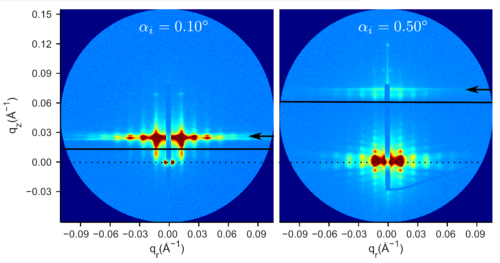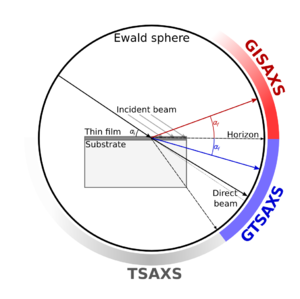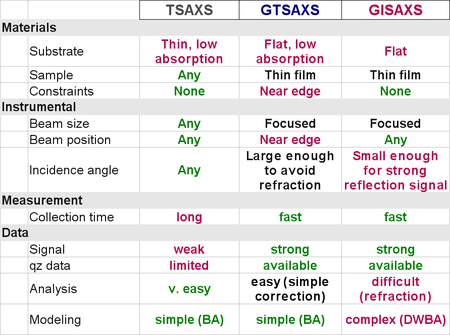GTSAXS
GTSAXS, or Grazing-incidence Transmission Small-Angle X-ray Scattering is a variant of GISAXS; i.e. it is a surface-sensitive x-ray scattering technique. In GTSAXS, the x-ray beam is directed towards the edge of a sample (rather than the center). This small geometric difference allows the sub-horizon scattering (which is normally attenuated due to substrate absorption) to escape from the sample edge, and be recorded. This sub-horizon scattering is 'cleaner' than conventional GISAXS data. In particular, it suffers much less from the refraction-induced distortion of reciprocal-space and the multiple scattering effects that plague conventional GISAXS.

Contents
Comparison
GTSAXS can be thought of as a combination of a transmission-scattering (TSAXS) and grazing-incidence (GISAXS). In some sense, it combines the simple of data analysis of TSAXS with the surface-sensitive probing of GISAXS.
The main disadvantage of GTSAXS is sample preparation: the material of interest must be near the edge of the substrate. Standard film preparation methods may not yield a representative material near edges. For instance, spin-coating frequently leads to material build-up near substrate edges; this thicker region will dominate the GTSAXS signal, and not be representative of the thin-film structure in the center of the substrate. This can be easily overcome by cleaving substrates, so as to expose a representative edge for probing.
References
Technique
- Lu, X.; Yager, K.G.; Johnston, D.; Black, C.T.; Ocko, B.M. Grazing-incidence transmission X-ray scattering: surface scattering in the Born approximation Journal of Applied Crystallography 2013, 46, 165–172. doi: 10.1107/S0021889812047887
- Mahadevapuram, N.; Strzalka, J.; Stein, G.E. Grazing-incidence transmission small angle X-ray scattering from thin films of block copolymers J. Polymer Sci. Part B Polymer Phys. 2013 51, 602610. doi: 10.1002/polb.23261
Using Technique
- Weidman, M.C.; Yager, K.G., Tisdale, W.A. Interparticle Spacing and Structural Ordering in Superlattice PbS Nanocrystal Solids Undergoing Ligand Exchange Chemistry of Materials 2015 doi: 10.1021/cm503626s
- Liu, J.; Yager, K.G. Unwarping GISAXS data IUCrJ 2018, 5, 737–752 doi: 10.1107/S2052252518012058
- Xinxin Xia, Tsz-Ki Lau, Xuyun Guo, Yuhao Li, Minchao Qin, Kuan Liu, Zeng Chen, Xiaozhi Zhan, Yiqun Xiao, Pok Fung Chan, Heng Liu, Luhang Xu, Guilong Cai, Na Li, Haiming Zhu, Gang Li, Ye Zhu, Tao Zhu, Xiaowei Zhan, Xun-Li Wang & Xinhui Lu Uncovering the out-of-plane nanomorphology of organic photovoltaic bulk heterojunction by GTSAXS Nature Communications 2021, 6226 doi: 10.1038/s41467-021-26510-6
Using Technique: for Gratings
- Nikolay A. Vinogradov, Gary S. Harlow, Francesco Carlà, Jonas Evertsson, Lisa Rullik, Weronica Linpé, Roberto Felici, Edvin Lundgren Observation of Pore Growth and Self-Organization in Anodic Alumina by Time-Resolved X-ray Scattering ACS Applied Nano Materials 2018, 1(3), 1265-1271 doi: 10.1021/acsanm.7b00303
- Giuseppe Abbondanza, Alfred Larsson, Lorena Glatthaar, Tim Weber, Malte Blankenburg, Zoltan Hegedüs, Ulrich Lienert, Herbert Over, Edvin Lundgren Anisotropic strain variations during the confined growth of Au nanowires Applied Physics Letters 2023, 122, 123101 doi: 10.1063/5.0138891

